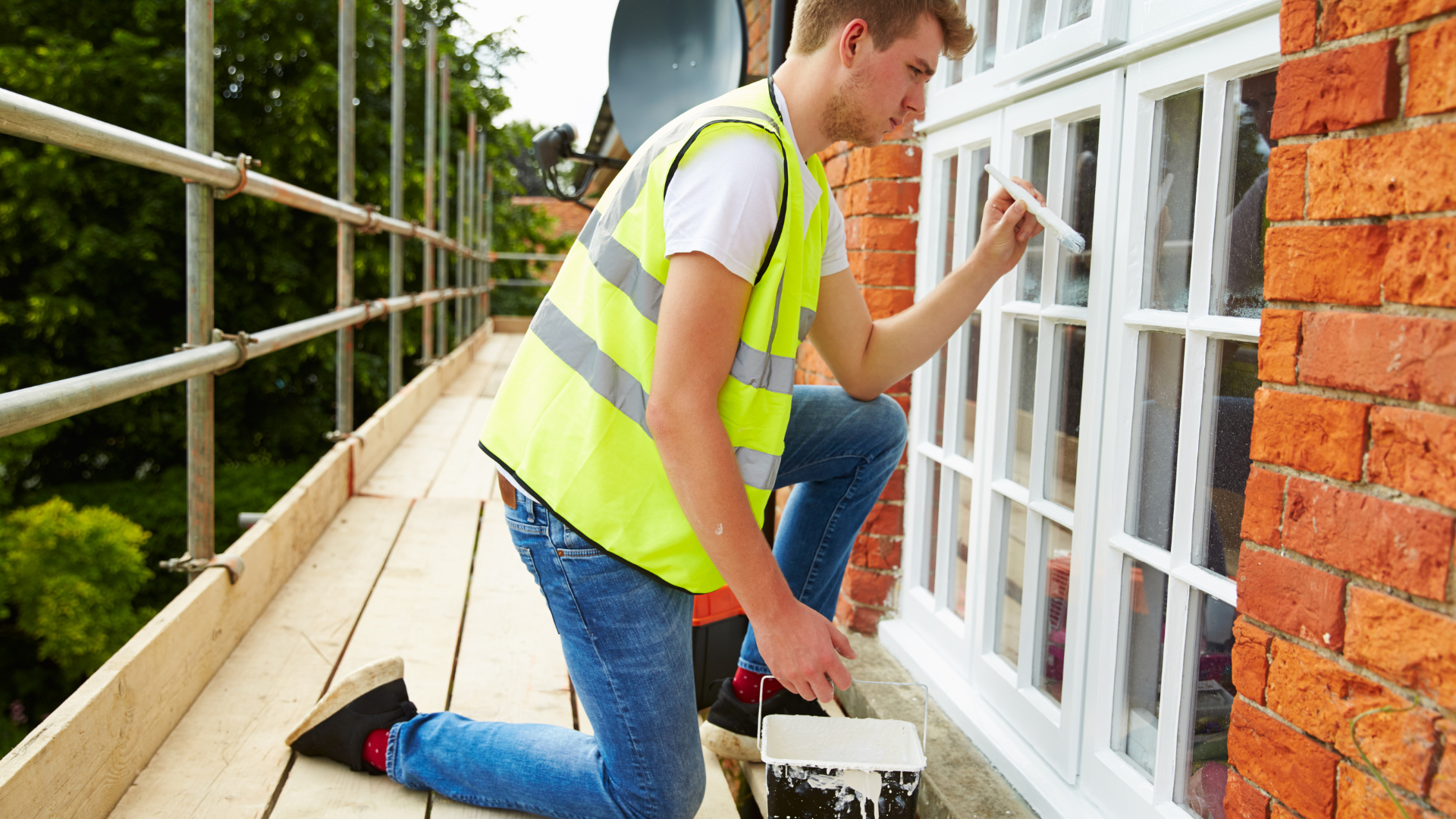Are you tired of the dull and dated look of your home’s exterior? Want to give it a refresh but don’t know where to start? Look no further! In this blog post, we’ve compiled 10 essential tips for painting your home exterior like a pro.
Before we go any further, it is important to note that painting your home exterior is a challenging task. It takes a lot of precision and can be a very time-consuming task. So, if you don’t have the time to do it, or the patience to see it through, you can contact your local Painter in Chattanooga (if that is where you live) and let them take on the task.
That said, there’s no saying that you cannot do it on your own. From preparation to execution, we’ll guide you through each step so that you can achieve a flawless finish and add instant curb appeal to your property. So, grab your paintbrushes, and let’s get started!
Prepare the Surface
The first step to painting your home exterior like a pro is to properly prepare the surface. This means cleaning the surface of any dirt, grime, or debris that could interfere with the paint’s ability to adhere to the surface. For best results, use a pressure washer to clean the siding (being careful not to damage any delicate areas) and then allow it to completely dry before starting any painting.
Choose the Right Paint
Paint is the most important part of any painting project, so it’s important to choose wisely. There are a few things you should keep in mind when choosing paint for your home exterior:
- The type of paint you use will depend on the material of your home’s exterior. For example, if your home is made of wood, you’ll need to use a different type of paint than if it was made of brick or stone.
- The climate in your area will also affect the type of paint you use. If you live in an area with high humidity, you’ll need to choose a paint that can withstand that environment.
- You should also consider the color of your home when choosing paint. A light color will reflect more heat, while a dark color will absorb more heat. Choose a color that will complement your home’s style and surroundings.
Apply Primer
Before you can paint your home’s exterior, you’ll need to apply a primer. This will help the paint to adhere to the surface and also provide a better surface for the paint to grip. Make sure to use a primer that is specifically designed for outdoor use. Once the primer is dry, you can begin painting the exterior of your home. Be sure to use good quality exterior paint and follow the manufacturer’s instructions for the best results.
Select the Right Tools
No matter if you’re a first-time painter or a seasoned pro, having the right tools for the job is essential for painting your home exterior like a true professional. From ladders and scaffolding to paint brushes and drop cloths, here’s a list of must-have items to help make your next exterior painting project a success.
Ladders & Scaffolding
Painting your home’s exterior often requires reaching high up or working in hard-to-reach places. That’s why having a quality ladder or scaffolding is crucial. Choose a ladder that’s tall enough to safely reach the area you need to paint, but not so tall that it becomes unstable.
Paint Brushes
When it comes to painting brushes, there are two main types, these are natural bristle and synthetic. For most exterior painting projects, synthetic brushes will do the trick. But if you’re using an oil-based paint, make sure to grab some natural bristle brushes too.
Paint Rollers
Paint rollers are another essential tool for painting your home’s exterior. They can help you achieve an even coat of paint on large spaces quickly and efficiently.
Drop Cloths
Keeping your floors and furniture protected from paint is one of the most important steps in painting your home exterior. So make sure to grab some drop cloths before you get started.
Paint in the Right Order
Start with the gutters and downspouts. These are often overlooked, but they play a vital role in protecting your home from water damage. Make sure they are clean and free of debris before you start painting. Next, focus on the trim around doors and windows. This is where a lot of peeling and chipping paint tends to occur. Scrape away any loose paint and sand down any rough edges before applying fresh paint. The siding is the next big area to tackle. Start at the top and work your way down, using a ladder or scaffolding as needed. Be sure to caulk any gaps or cracks before painting to create a seamless finish. Finally, paint the front door and shutters (if applicable). These are high-use areas that will show wear and tear more quickly than other parts of the exterior. A fresh coat of paint will give them new life and help them stand out against the rest of the house. For those who are making their first attempt at painting, it can be quite tricky. In case you’re unsure but still want the paintwork to look professional, consider hiring skilled painters who specialize in exterior painting burnaby, or in your local area. Professional painters have the experience and knowledge of what exterior paints work best for different materials and climates. They also know the right techniques to use to get the best results. so, hiring an experienced painter can save you time and money in the long run.
Make Sure to Caulk
One of the most important steps in painting your home exterior is making sure to caulk all cracks and crevices. This will help create a barrier between the old paint and the new, preventing peeling and flaking. You can buy caulk at any hardware store.
Clean Up After Each Coat
After each coat of paint, it’s important to clean up any brushes, rollers, or other materials you used. This will prevent the paint from drying on them and making them unusable for future projects. To clean your brushes, simply dip them in some warm water and soap. Then, use a brush comb or your fingers to remove any dried paint from the bristles. Rinse the brush off with clean water and let it air dry. Rollers can be cleaned similarly. Soak them in warm water and soap, then use a roller cleaner or your fingers to remove any dried paint. Rinse the roller off with clean water and let it air dry before using it again.
Protect Your Property
You should take steps to protect your property before you start painting. This includes covering any outdoor furniture or landscaping with drop cloths, tarpaulins, or plastic sheeting. You should also remove any hardware from the exterior of your home, such as doorknobs, light fixtures, and address numbers. These can be reinstalled after you’ve finished painting.
Seal Your Paint Job
It’s important to seal your paint job to protect it from the elements. You can do this by applying a clear sealer or a topcoat of paint. Be sure to follow the manufacturer’s instructions for application and drying times.
Perform Maintenance and Touchups
It’s important to regularly check your home exterior for any signs of damage and perform touchups as necessary. Be sure to inspect both the paint job itself and the trim and siding around doors and windows. If you see any cracks, chips, or peeling paint, address them as soon as possible. In addition to touchups, you should also perform regular maintenance on your home exterior. This includes cleaning the surface of dirt and debris, as well as power washing it every few years.
When to Call a Professional House Painter?
Calling a professional house painter like the ones available at Surepaint and similar companies is a decision that should be made considering various factors to ensure the best outcome for your home. The need for professional painting services can arise for several reasons.
Firstly, when your home requires a complete makeover, or if you’re planning to change the color scheme of your house significantly, a professional house painter becomes invaluable. Their expertise in color selection and execution will help you achieve the desired results.
Secondly, extensive preparation work, such as repairing damaged walls or dealing with mold and mildew, often requires professional attention. These issues can’t be overlooked, as they can affect the quality and longevity of your paint job. Professional painters possess the skills and tools needed to handle these repairs effectively.
Another scenario necessitating professional painters is when your project involves specialized techniques or finishes. Whether you desire intricate textures, decorative effects, or faux finishes, professional painters have the experience and training to bring your vision to life.
Additionally, large-scale projects or homes with challenging architectural elements may be best handled by professionals. They have the workforce and equipment to efficiently complete the task, ensuring a smooth and high-quality finish. This includes multi-story homes, vaulted ceilings, or properties with complex design features.
If you lack the time or expertise to undertake a DIY painting project, it’s wise to engage professionals. House painting can be time-consuming, and without the right knowledge, it may not yield the desired results. Hiring professionals not only saves you time but also guarantees a professional finish.
Lastly, if you’re looking for a long-lasting and durable paint job, professionals are your best bet. They select high-quality paints and know the appropriate techniques to ensure your paintwork remains pristine for years, even in challenging weather conditions.
In summary, calling a professional house painter is advisable when you need a complete home makeover, face extensive preparation work, require specialized techniques or finishes, tackle large-scale or architecturally complex projects, lack the time or expertise for a DIY project, or desire a long-lasting, high-quality paint job. The decision ultimately depends on your specific needs and the outcome you want to achieve for your home.


